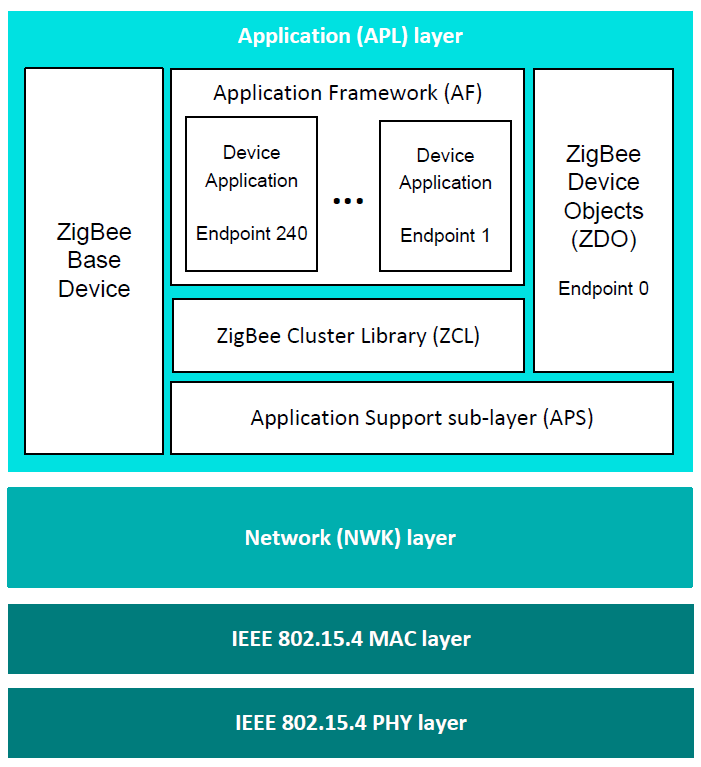Detailed architecture
This section elaborates on the simplified software architecture presented in “Section 3.1”. The detailed architecture is illustrated in the figure below.
Detailed software architecture

Software levels
The preceding figure Figure shows the architecture diagram (from top to bottom).
Application (APL) Layer
This includes:
Applications: Up to 240 application instances can be supported on a single ZigBee node. Each application instance communicates via an endpoint, where endpoints are numbered between 1 and 240 (note that endpoint 0 is reserved for the ZDO of the node - see below).
Application Framework (AF): The AF facilitates interaction between the applications and the APS layer (see below) through an interface known as a Service Access Point or SAP.
ZigBee Device Objects (ZDO): The ZDO represents the ZigBee node type of the device (Coordinator, Router, or End Device) and has a number of communication roles. The ZDO communicates via endpoint 0. For more information, refer to “Section 3.4.7”.
ZigBee Base Device: This device is required for all ZigBee 3.0 nodes and deals with essential tasks for the whole node, such as commissioning. It does not occupy an endpoint.
ZigBee Cluster Library (ZCL): The ZCL provides the standard ZigBee clusters used by the device applications that run on the endpoints.
Application Support sub-layer (APS): The APS layer is responsible for:
Communicating with the relevant application - for example, when a message arrives to illuminate an LED, the APS layer relays this instruction to the responsible application using the endpoint information in the message.
Maintaining binding tables (see “Section 3.6.2”) and sending messages between bound nodes.
Providing communication with the Trust Centre to obtain authorization.
The APS layer has an associated database, called the APS Information Base (AIB). This contains attributes that mainly relate to system security.
Parent topic:Software levels
Network (NWK) layer
The NWK layer handles network addressing and routing by invoking actions in the MAC layer. It provides services for:
Starting the network
Assigning network addresses
Adding devices to and removing them from the network
Routing messages to their intended destinations
Applying security to outgoing messages
Implementing route discovery and storing Routing table information
The NWK layer has an associated database, called the NWK Information Base (NIB). This contains attributes required in the management of the NWK layer.
Parent topic:Software levels
Physical/Data link layers
This consists of the IEEE 802.15.4 PHY and MAC layers, described in Section 3.1,”Architectural overview”.
Note: The Security Service Provider (not shown in the figure) spans the APS and NWK layers, providing security services - for example, security key management, datastream encryption and decryption. It may use hardware functions provided in the node to perform the encode and decode operations efficiently.
Parent topic:Software levels
Parent topic:Detailed architecture
Parent topic:ZigBee PRO architecture and operation